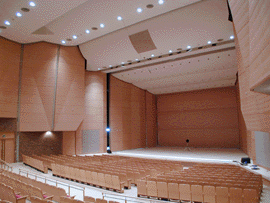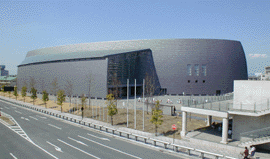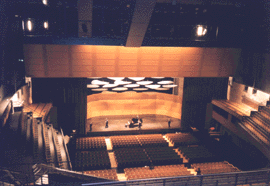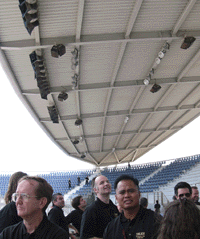
Title means "Quietness", "Comfortable Sound" and "Excellent Acoustics"
Nagata Acoustics News 04-06 (No.198)
Issued : June 25, 2004
Fukagawa City's "Mi-Rai" Cultural Exchange Hall
by Akira Ono and Motoo Komoda
Interior of the hall
 |
Fukagawa City is located in the middle of Japan's large northern island of Hokkaido, near the much larger city of Asahikawa. The city's population of about 27,000 keeps this city relatively unknown outside of the immediate area. Its residents live in a tranquil setting marked by winters filled with deep snow and summers filled with plenty of natural greenery. In April 2004, the city celebrated the opening of a new cultural facility named Mi-Rai Hall.
<< Origins of the Hall's Name >>
The clever name of the new hall was chosen by Fukagawa City from a large number of suggestions it received in response to an open invitation to the entire community for naming ideas. The "Mi-Rai" submission came from a local primary school student, who combined the two Chinese characters used in the phrase "come and see" to form a made-up word that is a homonym of the Japanese word for "future." The combination of "come and see" with the sound of the word for "future," surely expresses the city's sentiments about the new hall.
<< Project Participants >>
Kume Sekkei and Shibataki Architectural Firm jointly created the project's architectural design, and the locally based construction firm of Teraoka Construction was the project's builder. Shibataki Architectural Firm designed Asahikawa City's Crystal Hall, and the company has a reputation as that city's top architectural design firm.
<< The Facility's Two Halls and Their Sound Insulation >>
The new Cultural Exchange Hall building houses a 691-seat multipurpose hall, a workshop hall and a number of support rooms. The workshop hall is a flat-floored space designed for rehearsal use by all kinds of music, dance and other performing arts groups, and as a simple performance venue for individual and group recitals and similar events. Since the facility's opening in April, the workshop hall has already proven itself a popular venue for the artistic activities of many Fukagawa City residents.
The workshop hall shares a wall with the rear wall of the multipurpose hall's stage, and our acoustical design included focusing on achieving effective sound insulation between these two halls in order to accommodate their simultaneous use. To this end, we specified a double-layer wall between the two halls and implemented an anti-vibration and sound insulation structure. Our resulting design achieved a sound insulation level for 90 dB (at 500 Hz) between the workshop hall and the multipurpose hall, enabling the facility to hold events and performances simultaneously in both halls.
<< The Multipurpose Hall's Successful Conceptual Planning >>
During the planning phase of the project, the city proposed the requirement that the multipurpose hall be designed primarily for theatrical performances. The reasoning that the city provided for its requirement was that Fukagawa City has four theater groups, all of which perform regularly and are a vital part of the city's cultural life.
Typically, when a regional hall of this scale is designed primarily for theatrical performances, more than 50% of its utilization nevertheless ends up being for music performances. However, in the case of Mi-Rai Hall, the city entrusted the inaugural celebration's planning to the Fukagawa Theater Arts Company, and the city-sponsored, opening program schedule did include a healthy balance of theater performances, validating that this city's government has an accurate understanding of the community's cultural needs. Surely, this well-conceived facility will enjoy much popularity among the city's residents.
<< The Multipurpose Hall's Reverberation Time >>
The multipurpose hall provides an appropriate reverberation time to meet the needs of both classical music performances and theater performances. When the hall's orchestra shell is deployed for concerts, the reverberation time measures 1.5 seconds and when the stage curtain is used, the reverberation time is 1.1 seconds (both fully occupied at 500 Hz, estimated calculation based on the unoccupied hall's measured value).
<< A Stage Sound System Accessible by Remote Laptop Computer >>
In designing the multipurpose hall's stage sound system, we focused on clear speech amplification as the fundamental goal and installed loudspeakers primarily above the stage's proscenium and at both sides of the stage. In addition, for the digital mixer in the hall's control room, we selected a model that can be remotely controlled from a laptop computer located in the stage wings. When the hall is used for a speaking engagement that requires only basic sound system settings, the sound system's controls can be adjusted from the stage wings without the need for additional personnel in the control room.
The telephone contact number for the Fukagawa City "Mi-Rai" Cultural Exchange Hall is +81-164-23-0320.
An Acoustician's Return Visit to Nara Centennial Hall
by Chiaki Ishiwata
Exterior of Nara Centennial Hall
 |
As the lead acoustician for a new hall or cultural facility, I spend several years dedicated to a single project, from its design phase through the completion of construction, tuning and opening day. During these years, each facility gains a special place in my heart and memories. Like old friends not seen for a while, from time to time I think of each of them. If the facility is in Tokyo or one of its suburbs, it is relatively easy for me to make the time to attend a performance at the facility, but when the location is in a part of Japan distant from Tokyo, requiring travel by bullet train or airplane, visiting these old "friends" unfortunately becomes much more difficult.
Nara Centennial Hall is one of my former projects that I had been unable to visit for some time and I was wondering how the hall was prospering. So when the opportunity arose, last December, for an unrelated business trip to the Nara vicinity, and I found a conveniently scheduled concert on the hall's calendar, I eagerly included a stop at Centennial Hall in my trip itinerary.
<< Highlights of the Project and the Facility >>
Interior of Main Hall
 |
The Nara Centennial Hall project began in 1992 with an international competition for the selection of the project's architect. Arata Isozaki & Associates won the competition and designed a facility with many unique design elements. Since the hall's opening in February 1999, five years have already quickly passed.
The facility's main hall can be arranged in eight different seating and stage configurations, including center stage and end-stage options, making it an extremely versatile and flexible venue. (It may be easier for the reader to have a sense of the "flavor" of this room by thinking of it as an event space rather than as a hall.)
Contrasting with the main hall, Nara Centennial Hall's Harmony Hall is designed expressly for the performance of classical music and combines a traditional shoebox configuration with an abundant use of glass windows along the concert hall's side walls. Its reverberation time is a long 2.0 seconds.
For details, please refer to Issue 135 (March 1999) of this "News & Opinions" newsletter.
Since Nara Centennial Hall's design is totally unlike the large number of recently built Japanese regional halls, which are multipurpose halls with deployable orchestra shells, when the Nara facility's construction completed and the hall first opened, the hall's director and operational staff were somewhat at a loss as to how to best utilize and showcase their unique facility. They complained that they had planned to bring orchestras to the main hall, but that they could not move forward with this plan because the main hall did not have an orchestra shell. Regarding the Harmony Hall, they further complained that while its 434 seats makes it the perfect size for lectures and other speaking engagements, its long reverberation time makes it ill-suited for that purpose. While these assumptions about how the main hall and the Harmony Hall "should" be used did not reflect the objectives for the halls defined in the project's programming phase, nevertheless, they reflect standard approaches to hall use and fueled considerable grumbling about the then-new Nara Centennial Hall. In order to support the main hall's use for musical performances, we ended up suspending floating sound reflection panels from some of the hall's many overhead batons and we also provided a deployable, standing orchestra shell (on casters) that encloses the stage when rolled out as needed.
<< Strong Revenues Turn Around an Uncertain Future >>
So when I visited the hall recently, a complex set of memories filtered through my mind as I made my way to the hall's administrative offices to say hello to the hall's director and senior manager prior to attending a concert in the Harmony Hall. The hall's director, Mr. Uemura, and the hall's senior manager, Mr. Komada, were the same gentlemen who held these positions when the hall opened more than five years ago. As soon as I saw them, I greeted them with apologies for not having kept in touch and told them that I had come to hear a concert. Mr. Komada responded with an upbeat comment about his work keeping his energy level high. Then he explained his enthusiasm, saying, "Its amazing! Now our hall utilization rate puts us in the top rank of Japanese halls." Then he showed me headline articles from both a local and national-circulation newspaper.
2004.12.04 Sankei Shimbun Report
"Nara Centennial Hall's Finances Soon in the Black"
 |
Both the Nara Shimbun and Sankei Shimbun had written articles that began with the headline "Nara Centennial Hall's Finances Soon in the Black." Every five years, the Japanese Public Cultural Facilities Federation surveys the state of hall-sponsored programming at 1,500 public cultural centers and halls throughout Japan. The most recent survey based its report on data reported for the year 2001.
In 2001, Nara Centennial Hall sponsored 37 different engagements that included a total of 46 concerts, raising 85 million yen (US$763 thousand or 632 thousand Euro). The hall's expenses for that year totaled 99 million yen (US$895 thousand or 741 thousand Euro), for an income flow equaling 85% of the hall's expenses. This income-to-budget ratio earned Nara Centennial Hall third place among all the Japanese halls surveyed by the Federation, with only Nerima Cultural Center and Utsunomiya City Cultural Center reporting a higher income-to-expenses ratio. (Both of these first and second place halls are located in the Tokyo metropolitan area.) Adding to this favorable news was additional information from a survey by the Nara City Cultural Promotion Center forecasting a 10% growth in income for Nara Centennial Hall in 2002.
Apparently, the halls included in these surveys use a variety of different approaches to calculating and reporting their income and expense numbers, so other cultural centers and halls might debate the rankings. Nevertheless, for me, Mr. Uemura's and Mr. Komada's energetic, enthusiastic and happy countenances were undeniable proof of Nara Centennial Hall's successful operations.
<< Nara Centennial Hall's Successful Marketing Strategies >>
Mr. Uemura and Mr. Komada shared with me the following key factors that have led to the hall's marketing successes:
• Through contracts with professional concert promoters, and makeovers of their Internet home page and printed flyers, the hall increased the effectiveness of its advertising and publicity campaigns.
• The hall administrative staff and management set themselves the goal of making every concert a 100% box-office sell-out, and they achieved this goal by partnering with co-op organizations, credit unions and other groups with large memberships. Each of the management office's employees became personally involved in helping the ticket-sales campaigns reach the 100% goal.
• Once the hall began booking popular performers, Mr. Uemura and Mr. Komada learned that Nara's proximity to Osaka and the hall's convenient location near the JR train line's Nara Station enable the hall to sell tickets to Osaka residents unable to buy tickets for sold-out Osaka performances of their favorite artists. When Nara Centennial Hall realized that Osaka fans are willing to travel to Nara, they made this fact a selling point with the promoters of popular artists and the number of concert bookings at Nara Centennial Hall grew accordingly.
• The hall management realized that the unique configuration of its main hall, originally considered a handicap, could be positioned as an advantage. In particular, the use of the center-stage option gained the hall a strong following among concertgoers and made the hall a venue of choice for a wide spectrum of performers.
• For classical music concerts, the hall management recognized that, as a public facility, the main hall's casual, non-concert-hall atmosphere makes it the perfect venue for the much needed work of expanding the base population of people interested in this kind of concert. The hall's director instituted the approach of asking orchestra conductors and soloists to add a personal touch to their concerts by chatting with their audiences, from the stage, in-between each work performed. This tactic aims to put concertgoers who may have no background in the genre at ease and increase their appreciation of the music performed. Mr. Uemura hopes that by making this kind of music and performances accessible to the uninitiated, many first-time concertgoers will want to repeat the experience and return to the hall for future classical music performances.
• The Harmony Hall also found its niche. After the rocky start of being booked for Karaoke competitions, an event type that does not match the hall's acoustics, the Karaoke events disappeared from the hall's calendar and, one-by-one, the open calendar's days began to be filled with classical music bookings that allowed the hall to shine. Mr. Uemura says that once a classical music ensemble performs in this hall, they typically become repeat users of the venue.
As the reader can well imagine, I was delighted to learn that each of the halls at Nara Centennial Hall have "hit their stride," and are being used in ways that match the purposes for which they were designed when the halls were planned and built.
<< Nara Chamber Orchestra's Concert in the Harmony Hall >>
The concert that I attended during my visit was a performance by the Nara Chamber Orchestra in the Harmony Hall. The concert filled nearly every seat in the hall and the audience represented a broad assortment of young and old, male and female patrons. A voice using the public address system announced that the concert was about to begin, and I was forced to think about the hall's long reverberation time as it impacted (not so favorably) on the announcer's voice. But once the performance began, the hall brought rich reverberation and clarity of musical tone to the performance, which I enjoyed greatly.
In between the works on the evening's program, the conductor greeted the audience from the stage and, using a microphone, spoke about the pieces being performed. Unlike the fuzziness of the public address announcement, the conductor's words reached the audience seating with full clarity. Whether some difference between the public address announcement voice and the conductor's manner of speaking and enunciation contributed to this improvement in the clarity of the amplified speech, I am not sure. However, I was pleased to confirm that this hall's acoustics can successfully be used for lecture-with-concert events.
<< A Novel Audience Participation Idea for Classical Music Concerts >>
At this chamber music concert, I experienced a novel approach to audience participation called "The Conductor's Present." As part of the evening's program, the conductor asked the audience for a volunteer to come up on stage and conduct the chamber orchestra in the opening bars of Beethoven's Fifth Symphony. A man in late middle age immediately raised his hand and was selected by the conductor. When this volunteer ascended the stage and took the conductor's podium, it quickly became clear to both the audience and the orchestra that this amateur knew the entire symphony's score by heart. He conducted the opening minutes of the symphony and received resounding applause from both the audience and the members of the orchestra.
After the concert, I spoke with Maestro Norichika Iimori, the concert's conductor. He made two comments about the hall: that it has good reverberation and that the performers can hear themselves well on stage, making it an easy hall in which to perform. His words were surely music to this acoustician's ears!
My trip to Nara Centennial Hall allowed me to see how a project in which I participated has become a prosperous hall and matured into exactly the kind of energy-filled facility its planners and designers (including myself) hoped it would be. This was a meaningful visit for me and a story that I hope has value for you, the reader, as well.
Sound System Observation Tour of the 2004 Athens Olympics
by Makoto Ino
This past May, I joined Mr. Toshio Kojima, president of EVI Audio Japan, on an observation tour of the sound systems at the 2004 Athens Olympics facilities and at Athens' new airport. Approximately 100 sound system experts from numerous countries participated in the tour, including sound system equipment distributors, sound system installation contractors, acoustical consultants, and representatives of sound system professionals' organizations, plus the tour's leader, Telex Pro Audio Group company president, Mr. Mathias von Heydekampf. Telex Pro Audio Group was the company that installed the new airport's sound system.
<< Athens Airport Sound System >>
The first stop on our tour was the new Athens Airport, which opened in 2001. Here we observed and listened to the German company Dynacord's new Promatrix-brand digital network system, which has been installed as the airport's public address system. The network uses portable handsets distributed to airline counters and other locations from which public announcement capability is necessary. When a user speaks into the handset, the network carries both the voice signal and a digital control signal to the system's black box. At the black box, routing, sound level and sound quality adjustments are performed. The voice signal is sent to a power amplifier and the digital control signal is sent to an output relay that determines the area or areas of the airport where the voice signal is broadcast. The broadcast area settings, schedule-related changes, adjustments to and monitoring of the power amplifier and even fine-tuning of broadcasts' sound quality can all be controlled from a laptop computer.
<< The Olympic Stadiums' Loudspeakers >>
Speakers under the roof
at Beach Volley Stadium
 |
The next stops on the tour, and the main objective of our trip, were the Olympic facilities. We visited both indoor and outdoor facilities, including the riding grounds, the beach volley stadium and the gymnastics hall. The loudspeakers used in all of these facilities were made by the U.S. loudspeaker manufacturer Electro-Voice. It was obvious from the loudspeakers' installation that the plan is to use these loudspeakers for the Olympic events and then remove them. Most of the units used are from Electro-Voice's SX/RX model series.
The Electro-Voice SX/RX series are inexpensive loudspeakers. Nevertheless, when we listened to demonstrations of speech amplification in each of the facilities, we could hear that the loudspeakers' sound volume, sound quality and clarity attain performance levels that satisfy the needs of the facilities (amplification of announcers' contestant introductions and other informational announcements to the events' spectators). While we knew that the loudspeakers were not meant for music amplification, a CD was also played over the loudspeaker system for the tour participants to hear. The choice of Latin-style music for this demonstration was a perfect match for the sun-drenched surroundings under Greece's azure skies, and my memory of this moment is mostly of the happy, liberating sounds of the music mixed with the beautiful setting.
<< A Relaxed Approach to Sound Mixing >>
Each of the Olympic ground's facilities uses compact analog sound mixers manufactured by the English company Midas. This approach to sound mixing equipment is different than the standard Japanese approach which leans towards installing large sound mixing consoles with complex controls. Unlike massive pieces of equipment, the compact sound mixers provide practical functionality and a relaxed atmosphere. Sound systems that combine a focus on ensuring the right quantity and quality of loudspeakers with decisive opting for simple mixing equipment are common across both the United States and Europe, while this approach is not prevalent in Japan.
<< The Sound System at an Athens Nightclub >>
Of course, no overseas trip would be complete without a bit of nightlife. Our group visited a nightclub with live entertainment. The establishment was geared toward tourists and offered the lively clientele dancing, Karaoke singing, a full-service restaurant menu and a close-up view of the Mediterranean. The club had a DJ booth and the management kept both the singing and the recorded music at pretty high decibels. The carefree atmosphere and loud music truly made me feel that I was on vacation in a land with an ethos quite different than is the norm in Japan.
<< Our Chinese Colleagues Learn from Athens' Olympic Facilities >>
Among our group of sound system experts was a contingent from the National Stadium in Beijing and some other participants from China also engaged in the preparations for the next summer Olympics in Beijing. These participants' alertness to every aspect of the demonstrations and their reactions to the advanced sound system equipment sometimes reminded me of how I and my Japanese colleagues responded to advanced technologies we would see on trips to the United States and Europe some 20 or 30 years ago. The Chinese participants' knowledge and understanding of the technologies were totally up to speed, and with some exposure to how these technologies are being implemented, surely their designs and installations may also soon attain world-class levels.
Just as Japan spurted forward with rapid advances and high productivity in the latter half of the 20th century, these colleagues gave me a sense that China is on the brink of emerging as a true super-power in this realm as in others. When that happens, be it several decades -- or more or less -- in the future, I wonder what the lifestyle will be like in Japan, at the far eastern corner of Asia. I wonder if, like the people I saw in Greece, at the southeastern tip of Europe, we will be able to relax with our families and friends the way people seem to do in Athens today.
E-mail Distribution of Nagata Acoustics News & Opinions
We hope you have enjoyed this News & Opinions newsletter, available each month on our web-site (http://www.nagata.co.jp). We also offer e-mail delivery of the text version of this newsletter. To receive the text newsletter to your e-mail address, simply send the following information to us at newsmail_e@nagata.co.jp:
(1) Your e-mail address
(2) Your name
(3) The name of your company
By requesting the text version via e-mail, you will automatically receive every newsletter and you can still get the visuals and graphics at our web-site.
Nagata Acoustics News 04-06 (No.198)
Issued : June 25, 2004
Nagata Acoustics Inc.
Hongo Segawa Bldg. 3F, 2-35-10
Hongo, Bunkyo-ku, Tokyo 113-0033 Japan
Tel: +81-3-5800-2671, Fax: +81-3-5800-2672
E-mail: info@nagata.co.jp







